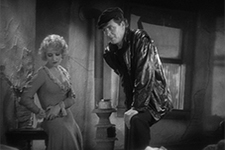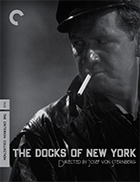The Docks of New York
|  The story in Josef von Sternberg’s The Docks of New York, his fourth production for Paramount Pictures in two years, is slight, but it is one the great director’s most visually impressive silent films. Awash in mist and smoke, it is a masterpiece of expressive light and shadow that lies somewhere between the radical experiments of the German Expressionists in the early 1920s and the adoption of their techniques by the directors of film noir in the 1940s. The film’s titular setting further connects it to noir, a genre strangely obsessed with water and piers, although its overall romanticism, rough-hewn though it may be, stands in stark contrast to the post-war emphasis in film noir on crime and betrayal and loss and fatalism. In The Docks of New York, the characters are in full command of their lives and act accordingly. In his second collaboration with von Sternberg after the 1927 hit gangster film Underworld, the indomitable George Bancroft plays Bill Roberts, a tough-talking, hard-living man who earns his living shoveling coal into the boilers of a massive steamship that is out to sea for months at a time. When the film opens, the ship has pulled into port in New York, and Bill and the other seamen have one evening on land before they must report back to duty. Washing off the oily sheen of coal dust and sweat that covers their bodies, the men head into port to spend their few free hours drinking at the Sandbar, which, like the Dream Café in Underworld and the titular cabaret in The Blue Angel (1930), is a quintessential von Sternberg space, packed with rowdy characters and constantly flirting with danger. Bill’s destiny does not reside in the Sandbar, however, but rather just outside of it where he saves a young woman named Mae (Betty Compson) from drowning herself in the harbor for reasons that are never made entirely clear (something to do with bad luck ...). While she is at first bitter that Bill has thwarted her suicide attempt, she soon takes him up on an offer to spend one night living life his way, which involves lots of drinking and carousing and fighting. She’s as thin and pretty as he is burly and rough, and they would seem to have nothing in common, especially since she has apparently given up on life, which she projects as cock-eyed attitude, while Bill, after spending so much of his time shoveling coal in a ship’s bowels, violently embraces every free moment he has. Yet, as the night progresses, they find a spark together, and Bill boldly proposes marriage right then and there (“You don’t know Bill Roberts. I’ll try anything once,” he roars). Of course, he is due back to sea the next morning and will likely be gone for months at a time, which puts the future of their sudden romance in imminent danger. While the conclusion is surprisingly sentimental and quite absurd (the screenplay was by Jules Furthman, who wrote eight of von Sternberg’s films and also wrote regularly for Howard Hawks), it can’t take away from the film’s astounding visual impact. The cinematographer Harold Rosson, who would go on to shoot such disparate cinematic landmarks as Victor Fleming’s The Wizard of Oz (1939), King Vidor’s Duel in the Sun (1946), John Huston’s The Asphalt Jungle (1950), and Stanley Donen and Gene Kelly’s Singin’ in the Rain (1952), turns each frame into a study in razor-sharp contrast, which is heightened by the almost dreamlike presence of billowing smoke and mist from which characters are constantly emerging and disappearing, often framed by fishing nets and crooked poles. As he did in both Underworld and The Last Command, his previous Paramount films, von Sternberg finds consistently intriguing ways to shape his avant-garde tendencies for mainstream tastes, creating a sense of poetic realism that is usually associated with French directors of the era like Jean Renoir and Marcel Carné (von Sternberg’s double life growing up in both Europe and the U.S. likely contributed to this tendency). So, for example, when Mae attempts to commit suicide, we don’t see it directly, but rather as a reflection in the gently undulating surface of the water, which underscores the sense of mystery around her character while also reflecting visually her despondent state of mind (similarly, von Sternberg depicts a murder via a flock of seagulls suddenly taking flight). The film’s most heartrending moment is a subjective shot that allows us to see how Mae can’t thread a needle through the tears in her eyes. His use of gliding camera movements—the kind that would become virtually extinct for several years after the adoption of synchronized sound, which required equipment that was too cumbersome for such agility—draws us into the filmic world (especially the raucous Sandbar), which is both gritty in its detail and yet slightly removed from reality. The resulting film is visually evocative and narratively intriguing, such that even its generally terrible ending can’t quite undermine the overall sense that you have just seen something profoundly of its time and ahead of it.
Copyright © 2019 James Kendrick Thoughts? E-mail James Kendrick All images copyright © The Criterion Collection | |||||||||||||||||||||||||||||||
Overall Rating: 


 (3.5)
(3.5)


 The Docks of New York is available exclusively via The Criterion Collection’s “3 Silent Classics by Josef von Sternberg” Blu-ray box set, which also includes Underworld (1927) and The Last Command (1928)
The Docks of New York is available exclusively via The Criterion Collection’s “3 Silent Classics by Josef von Sternberg” Blu-ray box set, which also includes Underworld (1927) and The Last Command (1928)